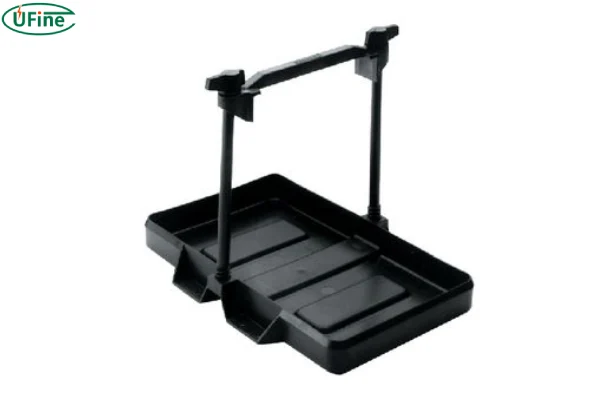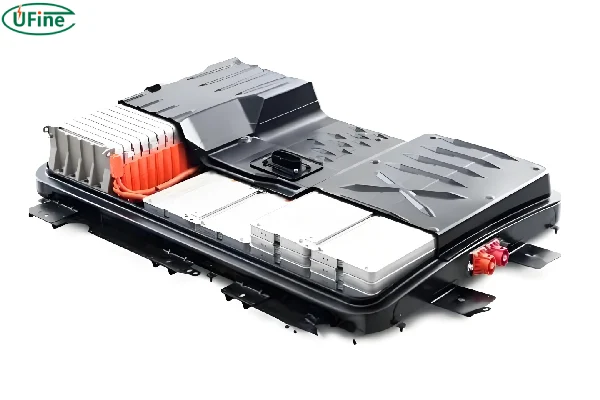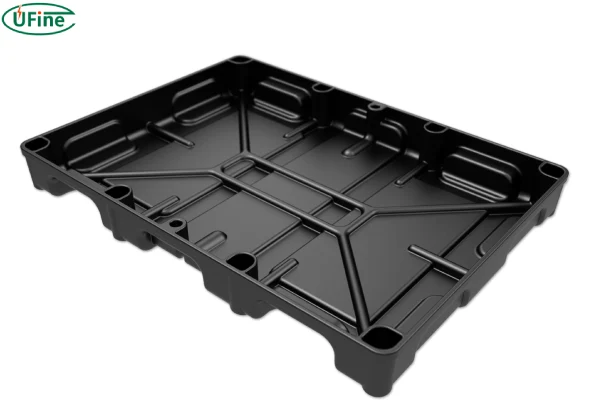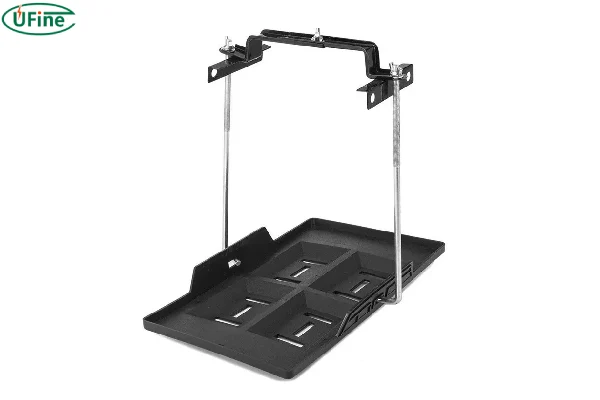Batteries are crucial components in various devices, from automobiles to renewable energy systems. However, how they are housed and secured can significantly impact their performance and longevity. This is where battery trays come into play. Battery trays are designed to hold and protect batteries, ensuring they remain secure and functional. In this guide, we’ll delve into what battery trays are, their uses, the various types available, how to use them, and how to select the perfect one for your needs.
Part 1. What is the battery tray?
A battery tray is a specially designed holder or container to secure a battery. These trays are essential for preventing batteries from shifting or moving, which can cause damage or even dangerous situations like leaks or short circuits. Typically, battery trays are made from robust materials such as plastic, metal, or composite to endure different environmental conditions. They come in various sizes and configurations to accommodate different types of batteries.
Part 2. What is a battery tray used for?
Battery trays serve multiple important functions, making them indispensable in many applications:
- Securing the Battery: The primary function of a battery tray is to keep the battery stable and secure. This is crucial in vehicles and other mobile applications where movement could cause the battery to shift.
- Protection: A battery tray protects the battery from physical impacts, vibrations, and environmental factors like moisture and dust. This protection helps extend the battery’s lifespan.
- Safety: By keeping the battery steady, a tray reduces the risk of short circuits, leaks, and potential fires, ensuring the safety of both the battery and the surrounding environment.
- Organization: In systems with multiple batteries, such as solar energy setups, battery trays help organize and neatly arrange the batteries, making maintenance and inspection easier.
Part 3. Types of battery trays
There are several types of battery trays available, each designed to meet specific needs and applications. Here’s a closer look at the different types and their characteristics:
1. Standard Battery Trays
These are the most common types of battery trays designed to hold standard-sized batteries. They are typically made from plastic or metal and are widely used in cars, boats, and various equipment.
Pros:
- Affordability: Standard trays are generally less expensive, making them an economical choice.
- Ease of Installation: They are straightforward to install and use.
Cons:
- Limited Size Options: They are designed for standard battery sizes, so they may not fit all batteries.
- Basic Protection: They offer basic protection but may not be suitable for extremely harsh conditions.
2. Adjustable Battery Trays

Adjustable battery trays are versatile and can be modified to fit different battery sizes. This makes them ideal for applications where the battery size may vary.
Pros:
- Versatility: This can accommodate various battery sizes, providing flexibility.
- Reusability: This can be reused with different batteries, making them a cost-effective option in the long run.
Cons:
- Higher Cost: Typically more expensive than standard trays due to their adjustable features.
- Complex Installation: It may require more effort and time to install correctly.
3. Heavy-Duty Battery Trays
Designed for demanding applications, heavy-duty battery trays are built from strong, durable materials to handle larger, heavier batteries and withstand harsh conditions.
Pros:
- High Durability: Made to endure tough environments and heavy use.
- Capacity: Can support larger and heavier batteries, making them suitable for industrial or high-performance applications.
Cons:
- Higher Cost: The robust construction and materials make these trays more expensive.
- Bulkiness: They tend to be larger and heavier, which can be a drawback in applications where space is limited.
Comparison summary
- Standard Trays: Best for regular use with standard-sized batteries.
- Adjustable Trays: Ideal for versatility and varying battery sizes, though they come at a higher cost.
- Heavy-Duty Trays: Suitable for large batteries and tough environments, but they are bulkier and more expensive.
Part 4. How to use a battery tray?
Using a battery tray properly is crucial for ensuring the safety and longevity of your battery. Here’s a step-by-step guide on how to use a battery tray:
- Choose the Right Tray: Select a tray that matches your battery’s size and your specific application needs. Consider the material and type of tray that best suits your environment.
- Install the Tray: Secure the tray in the desired location using the appropriate mounting hardware, such as screws or bolts. Ensure the tray is firmly attached to prevent any movement.
- Place the Battery: Carefully place the battery into the tray. It should fit snugly without too much play. If the tray is adjustable, make sure to adjust it to hold the battery securely.
- Secure the Battery: Use straps, clamps, or brackets to hold the battery firmly in place. This step is crucial to prevent the battery from shifting during operation or transport.
- Check Connections: Ensure all electrical connections are secure and free from corrosion. Proper connection is vital for the battery’s performance and safety.
- Regular Maintenance: Periodically check the tray and battery for any signs of wear, damage, or corrosion. Regular maintenance helps ensure the longevity and safety of your battery system.
Part 5. Which battery tray should I use for my battery?
Choosing the right battery tray involves considering several factors to ensure compatibility and optimal performance. Here are the key aspects to keep in mind:
1. Battery Size
Measure your battery’s dimensions (length, width, and height) accurately. The tray you choose must fit these dimensions snugly. If you have a non-standard battery size or anticipate changing battery sizes in the future, an adjustable tray might be the best option.
2. Application
Different applications require different types of battery trays:
Automotive: For car batteries, a standard tray often suffices. Ensure it fits well within the engine compartment and can withstand vibrations and heat.
Marine: For boats, choose trays that are corrosion-resistant and can handle exposure to moisture and salt water. Marine battery trays often come with additional features like built-in hold-downs to secure the battery against rough seas.
Heavy-Duty Equipment: For industrial or heavy-duty applications, opt for heavy-duty trays that can support the weight and size of larger batteries. These trays should be robust enough to handle harsh conditions and extensive use.
3. Material
The material of the battery tray affects its durability and suitability for different environments:
Plastic: Lightweight and resistant to corrosion, making it suitable for regular use in less demanding environments.
Metal: Provides strong support and is highly durable, ideal for heavy-duty applications. However, it may be prone to rust if not properly treated.
Composite: A blend of materials that offers a balance of strength and weight, often used in high-performance or specialized applications.
4. Mounting Options
Consider how and where you will mount the tray. Some trays come with specific mounting kits or hardware designed for particular applications, such as under-hood mounting in vehicles or floor mounting in boats and industrial setups. Ensure the mounting method is compatible with your installation requirements.
5. Budget
While it’s tempting to choose the least expensive option, investing in a quality battery tray can save you money in the long run by preventing battery damage and ensuring safety. Consider the total cost of ownership, including the durability and lifespan of the tray.
Summary
To choose the right battery tray:
- Measure your battery to ensure a proper fit.
- Consider the application to select a tray that can handle the specific conditions and demands of your setup.
- Choose the right material based on durability needs and environmental exposure.
- Evaluate mounting options to ensure compatibility with your installation.
- Balance your budget with the need for quality and longevity.
- By carefully considering these factors, you can select a battery tray that will protect your battery, enhance its performance, and ensure safety in your specific application.
By following this comprehensive guide, you can ensure you choose and use the right battery tray for your needs. Whether you’re securing a battery in a car, boat, or industrial equipment, the right tray makes all the difference in terms of safety, performance, and longevity. Happy battery securing!
Related Tags:
More Articles

LiPo Battery Discharge Rate Guide & Calculation Tips
Understand LiPo battery discharge rates, C-ratings, and how to calculate max current. Essential guide for RC, drones, and electronics users.
High‑Capacity 3S LiPo Batteries: 5000 mAh vs. 10000 mAh
Compare 3S LiPo 5000mAh vs 10000mAh batteries by weight, power, and use. Find the best fit for your drone, RC car, or boat setup.
Top 5 Applications for Small 3S LiPo Batteries
Small 3S LiPo batteries power drones, RC gear, wearables, and robotics with high energy and low weight. Making them ideal for compact electronics projects.
Building and Charging Your Own 3S LiPo Pack: A Step‑by‑Step Guide
Learn how to build, balance, and charge a 3S LiPo battery pack safely at home with this complete DIY guide for hobbyists and beginners.
How to Choose the Right LiPo Battery Plug Type?
Discover the best LiPo battery plug types, how to choose them, and expert tips for safe usage, soldering, and maintenance.






